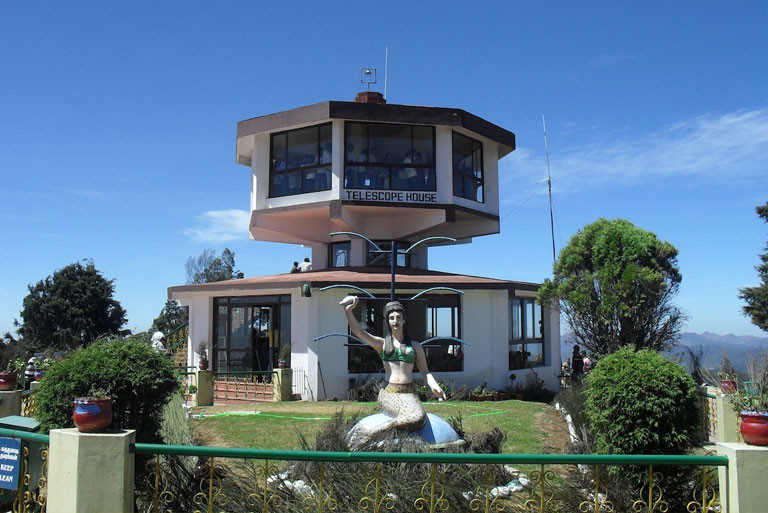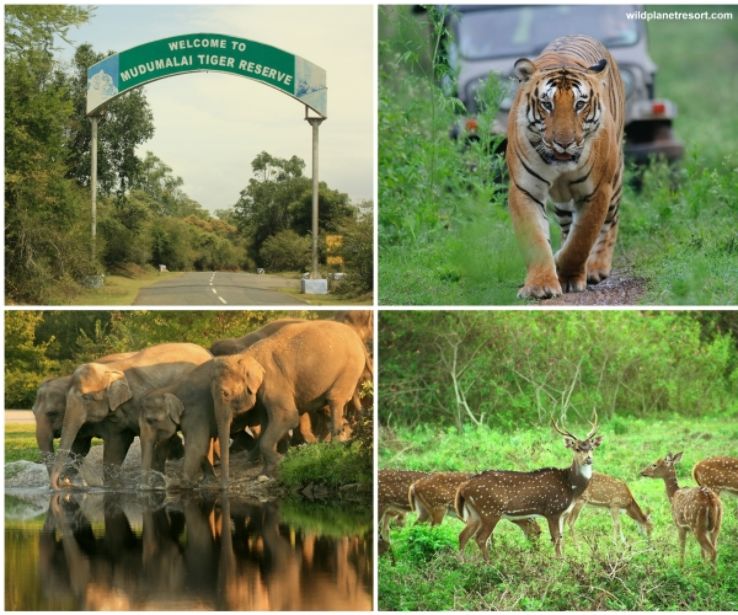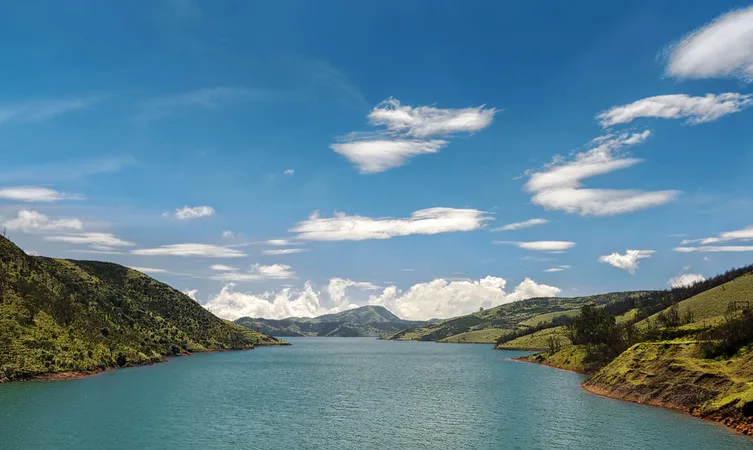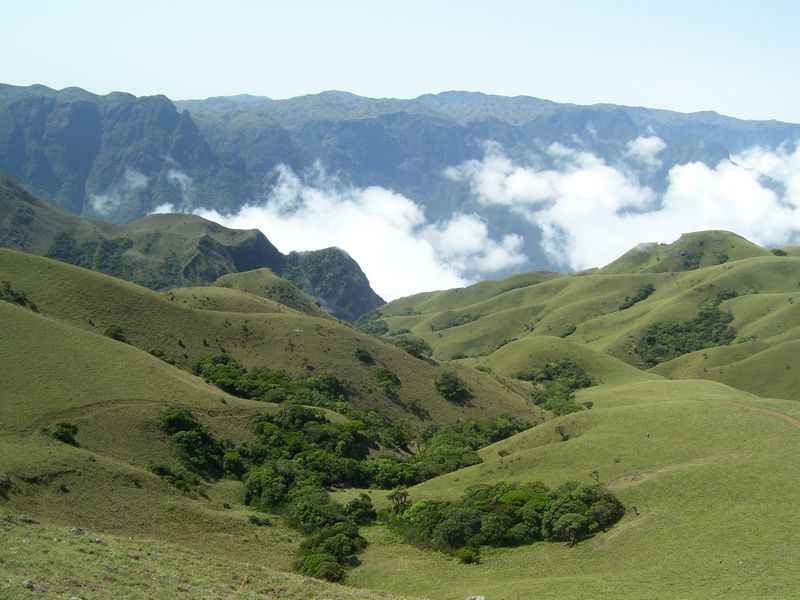Places Around Radio Astronomy Centre
| Govt Botanical Garden | |
 |
This garden was laid out in 1897 by the Marquis of Tweedale and is spread over 55 acres. Lush green, well maintained lawns, rare trees species (like the cork tree which is probably the only such tree in India, the paper bark tree and the monkey puzzle tree-monkeys cannot climb this tree), a 20 million year old fossilized tree, an Italian-style garden bordering a clear pool, a vast variety of flowering bushes and plants in myriad hues (exotic and ornamental), fern house with a vast range of ferns and orchids, are some of the many highlights of this garden. A flower show along with an exhibition of rare plant species is held every year in month of May at this garden. Best time of the year to visit: April, May & Sept. |
| Ooty Lake | |
The Ooty Lake is the pride of the Blue Hills. It is the central and strategic attraction. Mr. John Sullivan formed this artificial lake in the year 1824, the then Collector of Coimbatore. The Ooty lake which extends to an area of 65 acres. Earlier the entire lake was used for fishing. The Tamil Nadu Tourism Development Corporation on behalf of the Tourism Department took the possession of the lake for pleasure boating facilities in the year 1973. Another added attraction of the Ooty lake is the Mini Train and an amusement park. |  |
| Doddabetta | |
 | Doddabetta is the highest mountain in the Nilgiri Mountains at 2,637 metres (8,652 feet). There is a reserved forest area around the peak. It is 9 km from Ooty, on the Ooty-Kotagiri Road in the Nilgiris District of Tamil Nadu, India. It is a popular tourist attraction with road access to the summit. It is the fourth highest peak in South India next to Anamudi, Mannamalai and Meesapulimala. The peaks Hecuba (2375 m), Kattadadu (2418 m) and Kulkudi (2439 m) are the three closely linked summits in the west of the Doddabetta range near to Udagamandalam. |
| Mudumalai National Park | |
| Mudumalai Tiger Reserve is located in the Nilgiris District of Tamil Nadu state spread over 321 sq.km. at the tri-junction of three states, viz, Karnataka, Kerala and Tamil Nadu and it plays an unique role by forming part of the Nilgiris Biosphere Reserve, the first Biosphere Reserve in India, declared during 1986. It has a common boundary with Wyanad Wildlife Sanctuary (Kerala) on the West, Bandipur Tiger Reserve (Karnataka) on the North, and the Nilgiris North Division on the South and East and Gudalur Forest Division on the South West, together forming a large conservation landscape for flagship species such as Tiger and Asian Elephant. Reception Centre is located at Theppakadu. The name Mudumalai means ” the ancient hill range”. Indeed, it is as old as 65 million years when Western Ghats were formed. |  |
| Nilgiri Mountain Railway | |
 | The iconic Nilgiri Mountain Railway or Toy Train is one of the key attractions of the famous hill station Ooty in Tamil Nadu. There’s no denying the romance a train journey entails, but this particular one is for keeps – a throwback to sepia-toned times when life was slower, but we didn’t mind. It is an unforgettable journey through the winding mountains and scenic beauty of the Nilgiri ranges.This quaint and charming toy train was declared a World Heritage Site by UNESCO in 2005. The train’s journey began in 1899, and it has continued to capture the imagination of its visitors ever since. The Nilgiri Mountain Railway covers a total distance of 46 km in 5 hours. And what a stunning journey it is en route! |
Avalanche Lake

Avalanche Lake (Avalanchi lake) is located 28 kilometers from Ooty in the Nilgiris district.
The lake derived the name avalanche because of a huge landslide (avalanche) that occurred in the region in the early 1800s. Avalanche received 92.1cm rain in 24 hours on 9 August 2019 which is highest 24 hr Rainfall in South India. The day before it received 82 cm in 24 hr on 8 August 2019.
Avalanchi Lake is an important tourism destination in the Nilgiris district. The lake is surrounded by a rolling landscape with blooming flowers like magnolias, orchids and rhododendrons. Tourists can traverse beside the lake through winding paths around the lake. Tourists visiting the lake can also engage themselves in Trout fishing. A trout hatchery is established near the lake, from where visitors can get fishing rods and other fishing accessories required for trout fishing. The lake is also used by tourists as a camp site wherein they pitch tents near the lake. Other tourist activities in the area include rafting across the lake and trekking the nearby hilly regions like Upper Bhavani where there are thick forests and untouched wild habitats.
Emerald Lake

Encompassed by enchanting tea plantations, endless lush greenery and a peaceful atmosphere, the Emerald Dam is a beautiful lake where you can spend a perfect day overlooking the magnificent views. It is one of the topmost spots to enjoy the scenic sunrise and sunset in Ooty! Located in the upper region of Nilgiri district, the Emerald Dam boasts of an exotic species of ducks and other aquatic animals. Here you can dance to the tune of chirping birds, enjoy a variety of flora and fauna or feed the fishes belonging to different families. There is also a park on the right side for the entertainment of kids.
Upperbhavani Lake

Upper Bhavani Lake is situated at a distance of 10 km from Korakundah and over 20 km from Avalanche. The route to Upper Bhavani is replete with sholas trees and the entire area is a wildlife habitat. Tourists can go for trekking from Bangithapal through Sispara to the Silent Valley. For trekking in this region, it is necessary to get permission from the forest department. There is a huge dam on this lake, which is the major source of water for the nearby regions. This Upper Bhavani Dam is just 60 km from Ooty and is the ideal way to reach the Mukurthi National Park. There is a wildlife sanctuary at this place, which covers an area of 70 sq. km and is home to Nilgiri Tahr. This sanctuary also features sambhar, giant squirrels, leopards, tigers, jungle cats, wild dogs and jackals, among others. The entire region of Upper Bhavani, which gets over 5000 mm of annual rainfall, is dominated by the sholas and wattle plantations. This place is the perfect location for hiking, trekking and walking holidays. With the reservoir in the backdrop, there are few guest houses in Upper Bhavani for overnight stays
Mukurthi National Park

Bordered by Mudumalai National Park and Silent Valley National Park, the Mukurthi National Park is one of the best trekking places in Ooty. The park is part of the Nilgiri Bio Reserve which is India’s first Bio Reserve. The vegetation, climate and appearance of the Park bear a striking resemblance to that of the Himalayas minus the snow.
This wildlife sanctuary is also home to Mukurthi Peak, the fourth highest peak in the Nilgiri Hills. And at an altitude of 2,554m (8,379ft), the peak attracts many trekkers to visit these forests. But to trek your way up or to walk down the trails in the Mukurthi National Park, permission is required from the forest department.
Among the birds, you find eagles, vultures many exotic parrots and also migratory birds. The Mukurthi Park is famous for the Nilgiri Tahr, which is supposedly found only in the forests of these regions. Having said all this it is more than clear that the place is a paradise for true lovers of nature.
Ooty
Ooty, short for Ootacamund (an anglicized name for Udhakamandala), is a popular hill resort in the state of Tamil Nadu in Southern India. The name Udhakamandala is derived from the TODA word "othakal-mund" which means "house in mountains". Udhaka Mandala also means "Water Abode" in Sanskrit. Ooty stands at 7,347 feet above sea level in the Nilgiri mountain range. It served as the summer headquarters of the Madras Presidency.
Located in the mountainous range called the Nilgiris ("Blue Mountains"), it draws swarms of tourists every year. The weather is quite pleasant at a mean of 15-20°C around the year, dropping to lows of 0°C during winter. The landscape is marked by rolling hills covered with dense vegetation, smaller hills and plateaus covered with tea gardens, and eucalyptus trees. Many portions of the hills are preserved as natural reserve forests, and special permits will be needed to camp in noncamp sites. *Ooty, is not the destination in itself, as much as it is the focal point of attraction. Auto touring the surrounding country side is certainly a must do. Unfortunately, the hill town suffers from overcrowding and erosion of natural resources. Tourism has placed an enormous strain on the natural resources resulting in pollution, water shortage and roads. The hilly region also houses smaller towns like Coonoor and Kotagiri. These smaller towns are a better choice to visit and spend time in, since they are off the beaten path, yet less than 1 hour away from Ooty. They enjoy the same natural climes and prices are a lot cheaper.
